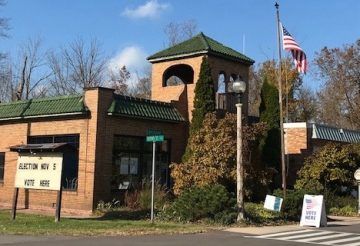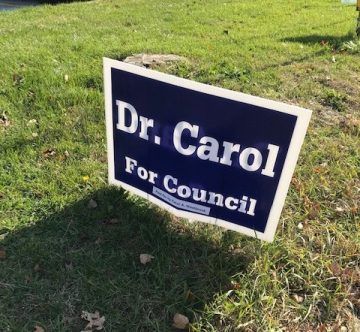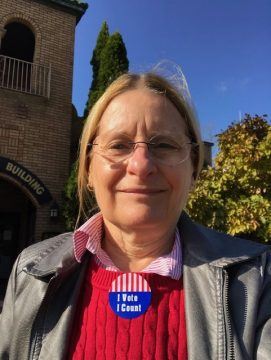by Carol A Westbrook

“You must be crazy,” the current Council president said to me. “Why do you want to run for Town Council?”
Being on the Beverly Shores Town Council was a thankless job. It paid only a small stipend, took up a lot of time in month meetings, committee meetings, and pubic events. There were always calls from irate residents–a tree is down, their trash was not picked up, why did they get a parking ticket, their road needs plowing. Many former councilors told me they started the post with many friends, and ended it with just as many enemies.
Why did I want to run? Was it election fever, inspired by twelve Democratic presidential candidates trying to grab the nomination? Did I have an urgent political agenda? Did I have to prove myself somehow? No, to all of these. The real reason I ran for office was because somebody had to do it.
As of March 2019–the deadline to file for a local primary election in the State of Indiana– there were only four candidates who declared for our Town’s five council seats, and one for Clerk-Treasurer. And they were all Democrats. There were also no independent or Republican candidates at that time, either. No need for a primary, but not enough candidates for five seats. Somehow that didn’t seem right. There should be at least five candidates, and they shouldn’t all be from the same party. The electorate deserve a choice. Somebody had to run.
So I threw my hat in the ring. I decided to put my name up for Councilor-at-Large in our little town of Beverly Shores, Indiana. I stress “little town.” We have a population of only 600 people, which means 2% of them would have to get involved in politics in order to have a full 2-party slate on the November ballot. That’s highly unlikely in any political jurisdiction. Think of it this way: if 2% of eligible voters in the US declared candidacy for the 2020 presidential election, there would be 3 million candidates on the debate stage, not just twenty!
In reality, our town has many more residents than 600, but for a number of reasons they don’t declare Beverly Shores as their primary residence, and thus are not eligible to vote or to run for office. There are many who declare primary residences elsewhere, typically Chicagoans with weekend or vacation homes in our Town–we call them “Some-timers. ” Other residents live in other states part of the year–that is to say, they winter in Florida–so it is convenient for one of a couple to claim residency in Florida, often for income tax purposes. Many some-timers and non-residents are our good friends, visible and active in the town, but as non-voters they have no voice in our government, and cannot run for office. For the most part, our electorate is highly educated, older (avg. age 62, compared to 37 elsewhere in the state), own their own home, and vote Democrat. It is a very unique electorate.
Running for office subjects the candidate many regulations. Most of these are laws to prevent fraudulent candidacy, expose conflict of interest, and to declare campaign contributions. The result is—paperwork! Many, many forms need to be filled out, all of which have firm deadlines. If you miss one, or get it wrong, your candidacy can be disqualified. I had to figure out what forms I needed to file, in what order, and what deadlines. The rules were different for major party candidates than for independents. Before filling out any forms, I would need to declare my party, if any: Republican, Democrat, or Libertarian.
Before going further, I have to explain that Beverly Shores is a political island. Our town is a relatively affluent exurb of Chicago, with a majority of liberal (should I say progressive?) Democrats, surrounded by a red state–that is to say conservative, Republican, mostly rural. But in a town as small as ours, which has so little legislative power, the national issues that divide our county have no relevance to our local candidates. Our town officials have no say in: health care policy, immigration, impeachment, climate change, foreign policy, trade, or even local taxes (more on that later). I didn’t want to be the fifth Democrat on the slate, because, as I said early, I wanted to make sure there was a choice. Still, running as a Republican would be certain political death in our town because of the current national mind-set, and the Libertarian philosophy doesn’t work for me.
So I would run as an Independent. This meant that I had to get 12 signatures, or 2% of the registered voters, so sign a petition of nomination, by mid-July. Easily done. At the next meeting of our month luncheon club, I passed my petition around to my friends for signature, along with campaign buttons which had the simple slogan, “Carol For Council.” I visited a few other venues, and all told I secured 29 signatures–almost 5% of the voters.
I took the forms to the Porter county courthouse in Valparaiso, along with the other required forms, all notarized: CAN-45, affirming my candidacy and listing my official ballot name as Carol A Westbrook, and CAN-12, economic interests and conflicts of interest. The signatures were verified, and I was officially certified as a candidate on May 15, 2019!
Now I had only 10 days to file my CFA-1 form, which establishes my finance committee, “The Committee to Elect Carol A Westbrook.” This committee required a treasurer who tracked campaign contributions and expenditures and published annual reports. Monitoring and reporting political contributions is a federal requirement that is critically important to our democratic process. However, if a candidate is running for local office, and the office pays less than $5,000 in yearly salary, and campaign expenditures are less than $500, then no CFA-1 needed, no Committee is required. Expenses so far: campaign buttons, $35. I expected to spend a little more on campaign signs, but that’s about all.
Two more people threw their hat in the ring–one was a Democrat currently serving on the Town council, and one was a Republican. This completed the Democratic slate, and added two other candidates. That made seven candidates for five offices. Our voters now had a choice.
The structure of small town government in Indiana is unique, and quite a bit different than it is in a typical US city. We have a 5-person Council, and a clerk-treasurer, who keeps records and balances the budget. The Council’s responsibility is to maintain order, pass and enforce laws, and preserve the integrity of the town. It oversees the building codes and zoning laws, maintains our parks and recreational facilities, organizes police protection, trash collection, boat permits, parking permits. Indiana Towns do not have any taxing authority, so we can’t increase our revenue stream for new projects. Our budget comes directly from the County, which levies our taxes and provides us with a fixed yearly amount. Since we can’t tax there is no way to fund new projects, raise salaries or hire more personnel And that’s probably just as well, because a well-intentioned Council with authority to levy taxes can do a lot of serious harm to a small Town.
Most importantly, the Town has the last word if important or divisive issues come up, as they have in the past: arranging municipal water service and a bond to pay for it, when the wells went dry 20 years ago; regulating the deer population to save the environment, over the protests of the animal rights activists 15 years ago, getting the Army Corps of Engineers to save our roads from washing out during high lake levels 25 years ago, and keeping the Beverly Shores from giving itself to the National Park Service some 40 years ago.
My platform was two-fold. I was in favor of increasing handicapped access in our public facilities, acknowledging the high number of seniors in our community. And I supported increased safety and security for our residents and their homes, in light of the ever-increasing number of National Park visitors wandering our Town in the summer months.
The National Park is the sleeping giant in our Town’s political landscape. Beverly Shores exists as a municipal island surrounded by Federal lands. Ever since the patchwork of holdings that was the National Lakeshore was consolidated and declared the Indiana Dunes National Park in 2019, we began to see an ever-increasing number of summer visitors, who clog the streets, park illegally, and wander through private property. Our residents are proud to live within this unique and fragile ecosystem, and work hard to preserve it. Most residents are neither aware nor concerned that the National Park might want to acquire their property–as they did for about two-thirds of the Town in 1966, 1970, 1972, and 1985. For now, land acquisition is not in the Park Service budget, and we can enjoy the beauty of our natural surroundings, along with 130,000 Park visitors.
Let the campaign begin! The next six months were a whirlwind of barbecues, rubber chicken dinners, helicopter rides, throwing first pitches at baseball games, kissing babies…just kidding. What followed was low key, and featured considerably less food. We candidates were asked for statements about our credentials and platforms from the Northwest Indiana Times, and from Sand Tracks, our local residents’ newsletter. There was a candidates’ Q&A forum sponsored by the League of Women Voters in the Town Hall. We were invited to interview at a local radio station–which turned out to be the station at Chesterton High School, interviewed by a high school sophomore doing a school project. He was actually quite good, and clearly had a promising career ahead of him, though he and most of his listeners were too young to vote.
But life got in the way. I was frequently away in the summer and fall. We had vacation plans, I had work commitments in Chicago, and a grandchild was on the way. I missed almost every Town event: the Necktie 5K run, the Summerfest, the ABSR Memorial Day and Labor Day brunch on the beach, Halloween Trunk or Treat. That’s how you campaign in this Town –go to the numerous social events, shake a lot of hands, and make friends. I realized then that it’s hard work to campaign, and it takes a lot of sacrifice and commitment. I probably also wouldn’t have the time it would take to serve on the Council.
My campaign signs went up in October, with the simple stated message, “Dr. Carol for Council.” (see the picture above). By Federal Law, I had to attach the message “paid for by…” to every sign. Other candidates followed suit. I put an ad Sand Tracks. Total expenditures were under $300–no CFA-1 needed.

November 5, 2019, election day. I went to the polling place early to cast my vote, and proudly wore my “I Voted. I Count” sticker. In this election, you could vote for up to five of the seven candidates, and the top five win the Council seat. We had new voting machines that were a bit skewed–the first screen made it easy for you to vote straight Democratic party, but there was not an option to vote straight Republican, and it was not easy to figure out how to vote for individual candidates. I may have lost a handful of votes due to this, and the Republican candidate probably lost more.
Here are the results of the election:
The voter turn out was 43%. It was not surprising that the straight Democratic ticket was elected. MG, the Republican candidate, came in pretty close to the last Democrat, and might have had a chance if the voting machines were not skewed toward straight Democratic Party. I, of course, came in last. So we have elected our new Council, which will be in office for four years.
I do not plan to run again in four years. I was glad of the experience; it was a good civics lesson for me. I truly came to appreciate how hard it is to campaign, and what our national candidates have to go through, with considerably more than 600 voters. I also know now why they call it “public service.” Running for office is hard, and being on the Council is even harder. Our new officials start in January 2020, and I wish them well.
